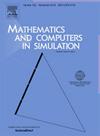An efficient parallel algorithm for solving viscoelastic wave equations
IF 4.4
2区 数学
Q1 COMPUTER SCIENCE, INTERDISCIPLINARY APPLICATIONS
引用次数: 0
Abstract
The high computational complexity of time-fractional viscoelastic wave equations limits their practical applications in seismic exploration and medical imaging. To address this challenge, this paper proposes a parallelized algorithm to address the practical application demands of viscoelastic wave equations. The method leverages the rapid decay property of cubic B-spline local wavelets in their dual space and designs perfectly matched boundary conditions (PMBCs) to achieve closure of local spline coefficients. This approach enables accurate global spline reconstruction with only localized communication between adjacent patches. Furthermore, by integrating the distributed-parallel local spline simulator (DPLS) with a short-memory operator splitting (SMOS) scheme, we develop an efficient solver for viscoelastic wave equations. Numerical examples in one-dimensional (1D), two-dimensional (2D), and three-dimensional (3D) viscoelastic wave propagation scenarios validate the convergence, accuracy, and computational efficiency of the proposed method.
求解粘弹性波动方程的一种高效并行算法
时间分数型粘弹性波动方程的高计算复杂度限制了其在地震勘探和医学成像中的实际应用。为了解决这一挑战,本文提出了一种并行化算法来解决粘弹性波动方程的实际应用需求。该方法利用三次b样条局部小波在其对偶空间中的快速衰减特性,设计完美匹配边界条件(pmbc)来实现局部样条系数的闭合。该方法可以实现精确的全局样条重建,仅在相邻斑块之间进行局部通信。此外,通过将分布式并行局部样条模拟器(DPLS)与短记忆算子分裂(SMOS)方案相结合,我们开发了一种高效的粘弹性波动方程求解器。在一维(1D)、二维(2D)和三维(3D)粘弹性波传播场景下的数值算例验证了该方法的收敛性、准确性和计算效率。
本文章由计算机程序翻译,如有差异,请以英文原文为准。
求助全文
约1分钟内获得全文
求助全文
来源期刊

Mathematics and Computers in Simulation
数学-计算机:跨学科应用
CiteScore
8.90
自引率
4.30%
发文量
335
审稿时长
54 days
期刊介绍:
The aim of the journal is to provide an international forum for the dissemination of up-to-date information in the fields of the mathematics and computers, in particular (but not exclusively) as they apply to the dynamics of systems, their simulation and scientific computation in general. Published material ranges from short, concise research papers to more general tutorial articles.
Mathematics and Computers in Simulation, published monthly, is the official organ of IMACS, the International Association for Mathematics and Computers in Simulation (Formerly AICA). This Association, founded in 1955 and legally incorporated in 1956 is a member of FIACC (the Five International Associations Coordinating Committee), together with IFIP, IFAV, IFORS and IMEKO.
Topics covered by the journal include mathematical tools in:
•The foundations of systems modelling
•Numerical analysis and the development of algorithms for simulation
They also include considerations about computer hardware for simulation and about special software and compilers.
The journal also publishes articles concerned with specific applications of modelling and simulation in science and engineering, with relevant applied mathematics, the general philosophy of systems simulation, and their impact on disciplinary and interdisciplinary research.
The journal includes a Book Review section -- and a "News on IMACS" section that contains a Calendar of future Conferences/Events and other information about the Association.
 求助内容:
求助内容: 应助结果提醒方式:
应助结果提醒方式:


